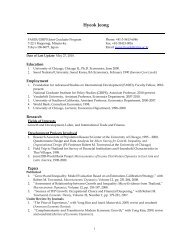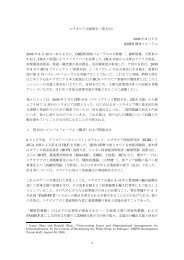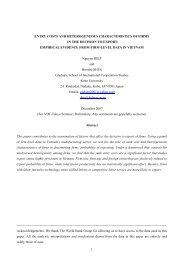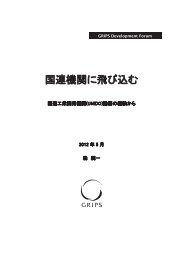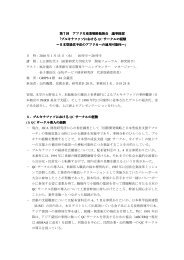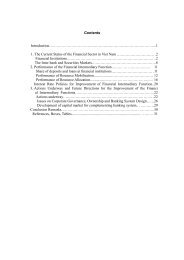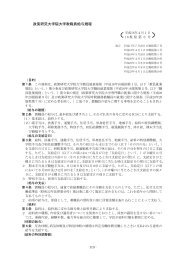The East Asian Growth Regime and Political Development
The East Asian Growth Regime and Political Development
The East Asian Growth Regime and Political Development
You also want an ePaper? Increase the reach of your titles
YUMPU automatically turns print PDFs into web optimized ePapers that Google loves.
<strong>The</strong> <strong>East</strong> <strong>Asian</strong> <strong>Growth</strong> <strong>Regime</strong><strong>and</strong> <strong>Political</strong> <strong>Development</strong>Kenichi Ohno (GRIPS)July 2007<strong>East</strong> Asia’sAchievements <strong>and</strong> Issues Diversity in performance Participation in the regionalproduction network Policy as key to economic success Authoritarian developmentalism asa dynamic <strong>and</strong> temporary regime <strong>The</strong> exit problem Democratic developmentalism?1
High PerformanceNo doubt about high average growthin recent decades4000Per Capita GDP(Measured in 1990international Geary-Khamis dollars)35003000250020001500Eas t As iaAfricaSource: Angus Maddison,<strong>The</strong> World Economy: AMillennium Perspective,OECD <strong>Development</strong> Centre,2001.100050001950 1960 1970 1980 1990 1998Diversity in <strong>Political</strong> <strong>and</strong>Economic <strong>Development</strong>Governance, WGI2005600500400300200MongVNCamb IndoE TTimor100PNGLaoN KorMya0100 1000 10000 100000MalTThaiPhilChinaSinS KorHkgJpnTTwnBruPer capita income ($PPP2004, log scale)High correlation(0.90) butcausality cannotbe argued fromthis diagramOnly circledeconomiesparticipate inregional dynamismSources: Compiledfrom World Bank,Worldwide GovernanceIndicators, Sep. 2006;<strong>and</strong> World Bank, World<strong>Development</strong>Indicators, 2006.2
<strong>East</strong> Asia’s Uniqueness <strong>The</strong> region is like a big factory wheremember economies compete <strong>Growth</strong> starts by participating in thisregional dynamism <strong>The</strong> s<strong>and</strong>wich effect—pressure fromabove <strong>and</strong> below to work harder FDI as relocater of industries Clear but shifting order <strong>and</strong> structure(flying geese)Manufactured ExportsManufactured exports / total exports100%90%80%70%60%50%40%30%20%10%JapanTTaiwanKoreaSingaporeMalaysiaTThail<strong>and</strong>PhilippinesIndonesiaChinaVietnamMyanmar0%1975197619771978197919801981198219831984198519861987198819891990199119921993199419951996199719981999200020012002200320042005Sources: <strong>Asian</strong> <strong>Development</strong> Bank, Key Indicators of Developing <strong>Asian</strong> <strong>and</strong> Pacific Countries, 1993 & 2006; Statistical Bureau,Ministry of Internal Affairs <strong>and</strong> Communications, Japan Statistical YYearbook 2007.3
<strong>Development</strong> <strong>and</strong> Aid Strategy<strong>The</strong>re is a clear gap in developmental thinkingbetween <strong>East</strong>ern practitioners <strong>and</strong> Western aidcommunity.GoalPoliciesKeyactors<strong>East</strong> Asia’s WayEconomic prosperity<strong>and</strong> national prideIndustry, investment,trade, technologyCentral government<strong>and</strong> businessesWestern DonorsPoverty reduction(MDGs)Health, education,governanceLocal communities<strong>and</strong> people<strong>East</strong> Asia’s Policy Mix4
<strong>Growth</strong> policies—vision, strategy, technology,HRD, infrastructure, SMEs, FDI, trade, finance,logistics, etc.Supplementary policies—inequality, pollution,urbanization, congestion, labor migration,corruption, drugs, HIV/AIDS, etc.--Rapid growth always creates newproblems, which destabilize society.--Unless both policies are implemented,development will fail (Murakami).--Success depends on these policies,rather than diligence or ConfucianismAuthoritarian <strong>Development</strong>alismE. Asia chose authoritarian developmentalism(AD) for economic take-off.Key ingredients of AD Powerful <strong>and</strong> economically literate top leader <strong>Development</strong> as a supreme national goal Technocrat group to support leader <strong>and</strong>execute policies <strong>Political</strong> legitimacy derived from growth<strong>The</strong> leader, as primary force of change,can create the other three conditions.5
Authoritarian <strong>Development</strong>alism in <strong>East</strong> Asia1945 50 55 60 65 70 75 80 85 90 95 2000KoreaTaiwanPhilippinesIndonesiaSingaporeMalaysiaThail<strong>and</strong>VietnamMyanmar60 61 79 87 88 92 97Noh TaewooRhee Syngman Park Chung-hee Chun Doo-hwanKim Dae-jung49 75 78 88 Kim Young-samNationalist Party Chiang Kai-shek Chiang Ching-kuo Lee Teng-hui46 48 53 57 61 65 86 92 98Magsaysay Macapagal 9955 59 65 90 HabibieLabor People'sLee Kuan-yewGoh Chok-tongParty Action Party57 70 76 8146 48 57 58 63 73 75 77 80 88 91 97IndochinaCommunist PartyQuirino Garcia Marcos Aquino51 76 Kriangsak Chatichai48 62 88RamosChenShuibianEstradaSkarno Suharto WahidUMNO / Rahman Razak Hussein MahathirPhibun Sarit ThanomLabor PartyPremVietnamese Communist PartyU Nu Burma Socialist Programme Party / Ne Win SLORCChuanSource: Akira Suehiro, Catch-up Type Industrialization , Nagoya University Press, 2000, p115.Emergence of AD AD emerges through a coup as well as election. AD is more likely to rise when the nation’sexistence is threatened by: External enemy Internal ethnic/social instability Incompetent <strong>and</strong> corrupt leader <strong>The</strong> rise <strong>and</strong> fall of AD is conditional mainly onthe development stage of each country, butinternational environment also influences them.Eg. Cold War – reduced global criticism of AD6
Why Power Concentration isNeeded? <strong>Growth</strong> requires a critical mass of mutuallyconsistent policies. A strong state is needed tomobilize resources quickly <strong>and</strong> flexibly. If broad participation is allowed, policies aretoo slow <strong>and</strong> can’t achieve critical mass due to:--Power struggle, party politics, interest groups--Processes requiring patience <strong>and</strong> compromise,including parliamentary debate <strong>and</strong> consensus building--Some groups may refuse to cooperate with statepurposesAdrian Leftwich (2005)“<strong>The</strong> institutional characteristics <strong>and</strong>requirements for development <strong>and</strong> fordemocracy pull in opposite directions.”“Democracies have great difficulty intaking rapid <strong>and</strong> far-reaching steps toreduce structural inequalities in wealth.”<strong>Development</strong>ChangeSpeed & flexibilityAccumulationDemocracyCompromiseAccommodationProcedure7
Critiques of ADDemocracy <strong>and</strong> development are separateissues:“I do not subscribe to the idea that youneed to delay democratization just so thatyou can actually have growth or that youcan have democracy only when you canafford it.” (Dani Rodrik, 2006)Democracy is required for development“Expansion of freedom is viewed both asthe primary end <strong>and</strong> as the principal meansof development.” (Amartya Sen, 1999)Korean ExperienceN.T.T.Huyen “Is <strong>The</strong>re a <strong>Development</strong>al Threshold forDemocracy?: Endogenous factors in the Democratizationof South Korea” (2004)“Democracy as an advanced form of politics isnot independent from socio-economicdevelopment.”“<strong>Development</strong>al threshold for democracy [is]a point in the development process beyondwhich democracy can be effectively installed<strong>and</strong> sustained.”8
10000900080007000600050004000300020001000080%farmersKorea: Per Capita GDP in 1990 USD90% middleclassEnd ofAD1960 62 64 66 68 70 72 74 76 78 80 82 84 86 88 90 92 94Exit of ADLowincometrapCatching-upperiod(AD useful)High incomesocietyDemocracyPluralism AD is a temporary regime of convenience,needed only to push up the country to a higherlevel. Once a certain level is reached, AD becomes anobstacle to further development. Watanabe (1998) argues that successful ADmelts away automatically through socialchange <strong>and</strong> democratic aspiration.“if development under authoritarian regime proceedssuccessfully, it will sow the seeds of its own dissolution”[improved living st<strong>and</strong>ards <strong>and</strong> diversified social strata]9
Exit of AD:A Less Optimistic View However, barriers do exit: stubborn leader,bureaucratic resistance, interest groups.<strong>The</strong>refore, leadership <strong>and</strong> strategy are alsoneeded for an exit. Strong leaders often refuse to step downbecause they will be revenged, jailed <strong>and</strong>even executed after transition, with most orall of their policies denied <strong>and</strong> reversed.<strong>The</strong> Exit Problem for One-partyRule (China <strong>and</strong> Vietnam) Rapid growth <strong>and</strong> social transformation drivenby private dynamism (local & FDI) Success so far in managing liberalization, butnot industrial activism Policy challenge is in social areas, notaccelerating growth Future options:(1) Greatly enhancing party’s policy capability(2) Multi-party system under social democracy(3) Other10
Democraticinstitution(Form)FulldemocracyConstitutionLawsParliamentElectionCourtPartySetbackPuredictatorshipReform vs conservatism, big vs smallgovernment, foreign policy, etc(Content)<strong>Political</strong>competitionDemocraticinstitution(Form)ConstitutionLawsParliamentElectionCourtPartyUS rule20071945-51DemocratizationNew constitutionDefeat<strong>The</strong> Case of JapanShowa2LDP dominanceLack of policy debateMilitary rises1931 Democracymovement,Party cabinetWar 1937Showa11960Male suffrage 1925TaishoFulldemocracyFascism1937-45ConstitutionParliament1889PuredictatorshipEdo<strong>Political</strong> fightsMeijiReform vs conservatism, big vs smallgovernment, foreign policy, etc(Content)<strong>Political</strong>competition11
“Democratic <strong>Development</strong>alism”?(Mild Form of AD) Research on DD--Robinson <strong>and</strong> White eds (1998)--Centre for Policy Studies study on “<strong>The</strong>Democratic <strong>Development</strong>al State in Africa”--Ethiopian Prime Minister Meles Zenawi Can we separate resource mobilization fromfreedom <strong>and</strong> human rights? Countries that already have free election,functioning parliament, human rights—canthey adopt developmental policies withoutthrowing out their political achievements? Need to decompose democracy into parts<strong>and</strong> analyze its structureComponents of DemocracyPurposesProceduresPropertiesFreedom, human rights, equality,social <strong>and</strong> economic benefits for all,security, peaceful coexistenceLegitimacy (election), rule of law,participation, multi-party system,balance of power (L-E-J), localautonomyTolerance, compromise, fairness,transparency, accountabilityR<strong>and</strong>om & excessive oppression should never be allowed.Can some of these restricted for resource mobilization?12
Designing DD:Tentative Suggestions Democratic criteria should go beyond“free election.” Generally speaking, policy purposesshould be upheld but procedures <strong>and</strong>properties may be partly adjusted. <strong>The</strong> executive branch should havesufficient power, but with a mechanismto overthrow it if it performs badly. Excessive decentralization at an earlystage is not desirable.Final Remarks When income is very low, a bottom-upregime based on rural population orsocial democracy (poor farmers or poorworkers) may not work. More realistic: use the <strong>East</strong> <strong>Asian</strong> ADmodel (top-down quick decisions withsupporting elites) with added democraticelements.13



